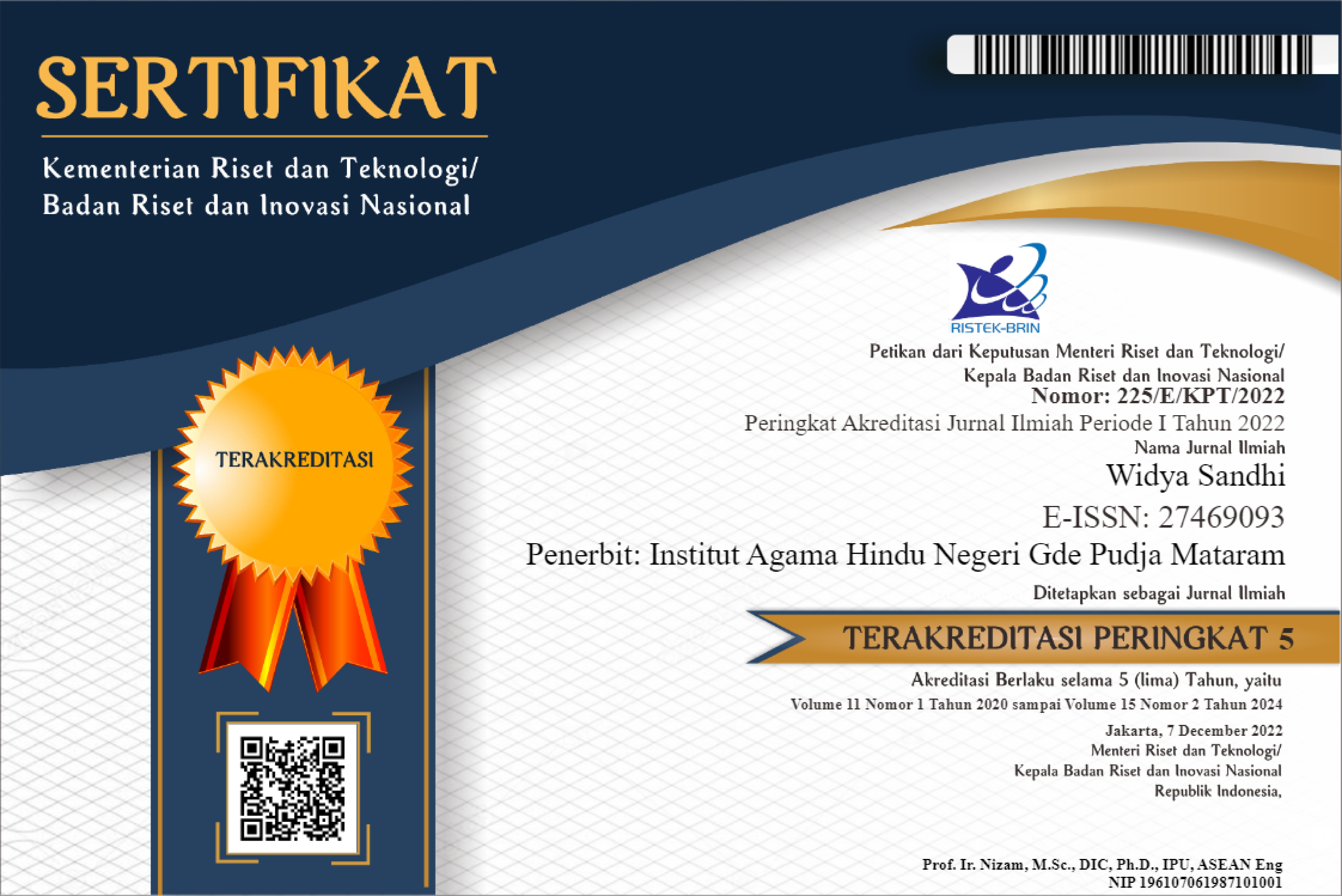ADAPTASI KONSEP PURUSA-PRAKERTI PADA PURA DANG KAHYANGAN KAPRUSAN DAN BATU BOLONG DI BATU LAYAR LOMBOK BARAT
Abstract
This study aims to conduct a study of the adaptation of the purusa-prakerti concept at the Pura Dang Kahyangan, namely Kaprusan and Batu Bolong in Batu Layar District, West Lombok Regency. This study was designed as a qualitative descriptive study in order to describe the concept of purusa-prakerti adapted in Hindu religious temple at Kaprusan and Batu Bolong. Data were collected through observation, interviews and document analysis. This study found that Dang Hyang Nirartha's journey in Lombok built a number of temples as a place to do yoga which is still used as a place to carry out Hindu religious activities. Kaprusan Temple and Batu Bolong Temple are two temples where yoga practice has a special identity, namely adaptation to the purusa-prakerti concept taught in the samkhya darsana system. The Kaprusan temple is cosmologically related to the presence of a burst of sea water hitting the walls of the rock cave which is termed kaprusan as a representation of the phallus (masculine). The phonological dimension gives the meaning of "kaprusan" as a word that is identical to ka-purusa-an. The Hindu community continues to identify the temple that has these characteristics as the “Kaprusan” temple as an adaptation of the Purusa concept. Batu Bolong Temple has an identity related to the presence of a large stone that has a large hole which is identified with yoni (feminine). Judging from the etymology, batu bolong has the meaning of a big stone that has a hole so that it becomes the background for naming the “Batu Bolong” temple which is associated with Samkhya teachings as an adaptation of prakerti.
References
Arikunto Suharsimi, (1998), Prosedur Penelitian Suatu Pendekatan Praktek, Jakarta : Rineka Cipta
Artadi, I Ketut. (2009). Kebudayaan Spiritualitas: Nilai makna dan martabat Kebudayaan Dimensi Tubuh, Akal , Roh dan Jiwa. Denpasar: Pustaka Bali Post
Abinash Candra Bosh, (1990), Panggilan Weda, terjemahan I Wayan Sadia, Jakarta : dharma Sarati
Cudamani, (1998), Bagaimana Umat Hindu Menghayati Ida sang Hyang Widhi, Surabaya : Paramita.
Dillistone, F.W. (2002). Daya Kekuatan Silbol: The Power of Symbols. Terjemahan A. Widyamartaya. Yogyakarta: Kanisius
Griffith Ralph T.H., (1986), The Hymns Of The Rg. Veda, Delhi : Motilal Banarsidass
Goundriaan T. and Hooykaas C, (1971), Stuti and Stava, Amsterdam-London : North-Holland Publishing Company.
Koentjaraningrat, (2004). Bunga Rampai Kebudayaan, Mentalitas dan Pembangunan. Jakarta: PT Gramedia Pustaka Utama
Nazir Mohamad, (1999), Metode Penelitian, Jakarta: Ghalia Indonesia
Nawawi, Handari. (1983). Metode Penelitian Bidang Sosial. Yogyakarta: Gajah Mada University Press
Ngurah I Gusti Made, (1999), Buku Pendidikan Agama Hindu Untuk Perguruan Tinggi, Surabaya: Paramita
Pudja, G, (1977), Theologi Hindu, Jakarta, Mayasari.
Pudja G., Wiana I K., Sindhu I.B. Kade , (1990), Tattwa Darsana , Jakarta : Dharma sarati
Rudia Adiputra I G., Suarjaya I W., Sura I G.,(1984), Tattwa Darsana, Jakarta : Departemen Agama
Soebandi, J.M.K.T. (2002). Babad Warga Brahmana: Pandita Sakti Wawu Rawuh. Denpasar: Pustaka Manikgeni
Sudarto,(1997), Metodologi Penelitian Filsafat, Jakarta: Raja Grafindo Persada
Sudharta Tjok. Rai,(2000), Arti dan Fungsi Upakara, Denpasar: Team Penyusun Pemprop. Bali
Suparta Ngurah Oka,(1999), Upacara Ngusaba Desa, Denpasar: Pemda Tingkat I Bali
Suprayogo Iman dan Tobroni. (2001). Metodologi Penelitian Sosial-Agama. Bandung: Remaja Rosdakarya
Tim Penyusun.(2006). Buku pendidikan Agama Hindu untuk Perguruan Tinggi. Surabaya: Paramita
Titib, I Made. (1998). Veda, Sabda Suci, Pedoman Praktis Kehidupan, Surabaya: Paramita
Vansina, Jan. (2014). Tradisi Lisan sebagai Sejarah. Terjemahan Astrid Reza, dkk. Yogyakarta : Ombak
Wiana I Ketut, (1993), Bagaimana Umat Hindu menghayati Tuhan, Jakarta: Pustaka Manikgeni
Triguna, I.B.Y. (1994). “Pergeseran Dalam Pelaksanaan Agama: Menuju Tattwa” dalam Buku Dinamika masyarakat dan Kebudayaan Bali. Editor: I Gde Pitana. Denpasar : BP
..............(2000). Teori Tentang Simbol. Denpasar: Widya Dharma
.................2003. “Konsepsi Sakral dan profan pada Masyarakat Bali. Dharmasmṛti: Jurnal Ilmu Agama & Kebudayaan. Vol. I Nomor 3 Nopember 2003. Denpasar: Program Magister Ilmu Agama & Kebudayaan niversitas Hindu Indonesia

This work is licensed under a Creative Commons Attribution-NonCommercial-ShareAlike 4.0 International License.
Authors who publish with this journal agree to the following terms:
- Authors retain copyright and grant the journal right of first publication with the work simultaneously licensed under a Creative Commons Attribution-ShareAlike 4.0 International License. that allows others to share the work with an acknowledgment of the work's authorship and initial publication in this journal.
- Authors are able to enter into separate, additional contractual arrangements for the non-exclusive distribution of the journal's published version of the work (e.g., post it to an institutional repository or publish it in a book), with an acknowledgment of its initial publication in this journal.
- Authors are permitted and encouraged to post their work online (e.g., in institutional repositories or on their website) prior to and during the submission process, as it can lead to productive exchanges, as well as earlier and greater citation of published work (See The Effect of Open Access).






.jpg)




